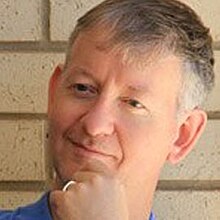Peter Gill (chemist)
Peter Gill | |
|---|---|
 | |
| Born | Peter Malcolm Wallace Gill 9 November 1962 Auckland, New Zealand |
| Alma mater | Australian National University |
| Scientific career | |
| Fields | Chemistry |
| Institutions | |
| Thesis | A theoretical approach to hemi-bonded systems and their dicationic analogues (1988) |
| Doctoral advisor | Leo Radom |
| Other academic advisors | John Pople |
Peter Malcolm Wallace Gill (born 9 November 1962)[1] is a New Zealand theoretical and computational chemist known for his contribution to density functional theory (DFT). He is an early and main contributor to the computational chemistry software Q-Chem and was the president of the company during 1998–2013. He is especially known for developing the PRISM algorithm for evaluating two-electron integrals and linear-scaling DFT, as well as self-consistent field method for excited state electronic structure.[2][3]
Education and career
Gill was born in Auckland and received his BSc in 1983 and MSc in 1984 from the University of Auckland.[1] He received a PhD in 1988 from the Australian National University under the supervision of Leo Radom. During this time, he investigated hemi-bonding and the convergence of perturbation theory in quantum chemistry.[3][4] After graduation, he conducted postdoctoral work with John Pople at Carnegie Mellon University from 1988 to 1993. Following this stint, Gill accepted a lectureship at Massey University in 1993. He became a lecturer at the University of Cambridge in 1996. In 1999, Gill became the inaugural chair of theoretical chemistry at the University of Nottingham. He moved to Australia and became a professor at the Australian National University in 2004 and later moved to the University of Sydney in 2019 as the Schofield Chair in Theoretical Chemistry.[3]
In 2001, Gill wrote an essay pronouncing the demise of density functional theory thanks to the rise of hybrid functionals for exchange interactions between electrons.[5][6]
Honors and awards
Gill is the president of the World Association of Theoretical and Computational Chemists (WATOC) and received the Dirac Medal in 1999[7] and the Schrödinger Medal in 2011 from WATOC.[1] In 2013, Gill received the Fukui Medal from APATCC. [1] Gill was elected a Fellow of the Australian Academy of Science in 2014[2] and received the David Craig Medal from the Australian Academy of Science in 2019.[8] In 2015 Gill was inducted to the International Academy of Quantum Molecular Science.[9]
References
- ^ a b c d "Peter Gill, International Academy of Quantum Molecular Science". www.iaqms.org. Retrieved 25 October 2023.
- ^ a b "Peter Gill". www.science.org.au. Retrieved 25 October 2023.
- ^ a b c Head-Gordon, Martin; Gilbert, Andrew T. B.; Loos, Pierre-François; Radom, Leo (19 May 2023). "Introduction to the Peter M. W. Gill special issue". Molecular Physics. 121 (9–10). Bibcode:2023MolPh.12119934H. doi:10.1080/00268976.2023.2219934. ISSN 0026-8976. S2CID 259457084.
- ^ Radom, Leo (5 December 2019). "Autobiography of Leo Radom". The Journal of Physical Chemistry A. 123 (48): 10348–10358. Bibcode:2019JPCA..12310348R. doi:10.1021/acs.jpca.9b07390. ISSN 1089-5639. PMID 31801352. S2CID 208646496.
- ^ Gill, Peter M. W. (2001). "Essay: Obituary: Density Functional Theory (1927-1993)". Australian Journal of Chemistry. 54 (11): 661–662. doi:10.1071/ch02049. ISSN 1445-0038.
- ^ Becke, Axel D. (1 April 2014). "Perspective: Fifty years of density-functional theory in chemical physics". The Journal of Chemical Physics. 140 (18): 18A301. Bibcode:2014JChPh.140rA301B. doi:10.1063/1.4869598. ISSN 0021-9606. PMID 24832308.
- ^ "Dirac - medal". watoc.net. Retrieved 25 October 2023.
- ^ "2019 awardees | Australian Academy of Science". www.science.org.au. Retrieved 25 October 2023.
- ^ "IAQMS news archive". www.iaqms.org. Retrieved 6 January 2024.
